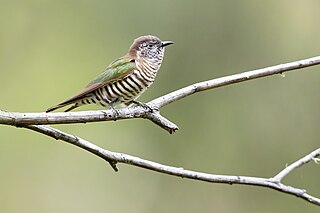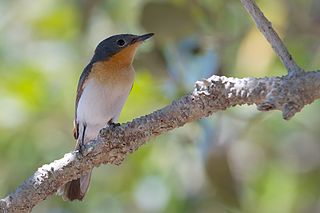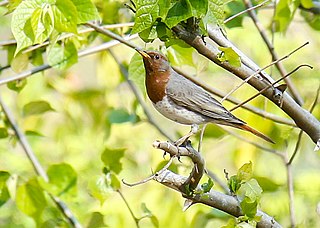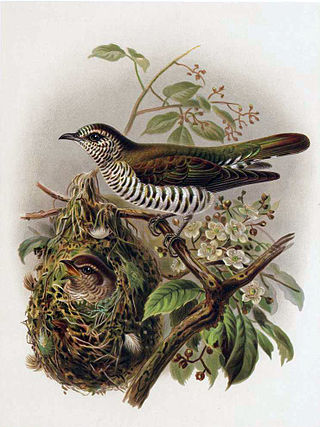
The red-breasted goose is a brightly marked species of goose in the genus Branta from Eurasia. It is currently classified as vulnerable by the IUCN.

The little grebe, also known as dabchick, is a member of the grebe family of water birds. The genus name is from Ancient Greek takhus "fast" and bapto "to sink under". The specific ruficollis is from Latin rufus "red" and Modern Latin -collis, "-necked", itself derived from Latin collum "neck".

The brown-necked raven is a larger bird than the carrion crow though not as large as the common raven. It has similar proportions to the common raven but the bill is not so large or deep and the wings tend to be a little more pointed in profile. The head and throat are a distinct brownish-black giving the bird its English name, while the rest of the plumage is black glossed with purple, blue or purplish-blue. Like the common raven, thick-billed raven and white-necked raven, it is one of the larger raven species. The feathers of this species often fade quite quickly to a brownish black and the bird can look distinctly brown by the time it moults. The feet, legs and bill are black. The dwarf raven was formerly considered a subspecies but this bird now appears to be closer to the pied crow than this species.

The red-necked stint is a small migratory wader. The genus name is from Ancient Greek kalidris or skalidris, a term used by Aristotle for some grey-coloured waterside birds. The specific ruficollis is from Latin rufus, "red" and collum, "neck".

The southern rough-winged swallow is a small swallow. It was first formally described as Hirundo ruficollis by French ornithologist Louis Vieillot in 1817 in his Nouveau Dictionnaire d'Histoire Naturelle.

The buff-rumped thornbill is a small passerine bird species belonging to the genus Acanthiza, most of which are endemic to Australia. Measuring 8–10 cm in length, this unassuming thornbill is characterised by its plain greenish brown upperparts and very pale-yellow underparts, with a distinctive buff coloured rump. The tail has a broad, blackish band with a paler tip. Adults possess white irises, whilst juveniles have dark eyes. The buff-rumped thornbill is one of 14 species within the genus Acanthiza genus, which are recognisable by their thin, pointed bill. Species are unique in their plumage and distribution. Despite their shared name, the genus is not related to hummingbirds.

Horsfield's bronze cuckoo is a small cuckoo in the family Cuculidae. Its size averages 22g and is distinguished by its green and bronze iridescent colouring on its back and incomplete brown barring from neck to tail. Horsfield's bronze cuckoo can be destiguished from other bronze cuckoos by its white eyebrow and brown eye stripe. The Horsfield's bronze cuckoo is common throughout Australia preferring the drier open woodlands away from forested areas. This species was formerly placed in the genus Chrysococcyx.

Chrysococcyx is a genus of cuckoos in the family Cuculidae.

The shining bronze cuckoo is a species of cuckoo in the family Cuculidae, found in Australia, Indonesia, New Caledonia, New Zealand, Papua New Guinea, Solomon Islands, and Vanuatu. It was formerly placed in the genus Chrysococcyx.

The white-eared bronze cuckoo is a species of cuckoo in the family Cuculidae. It was formerly placed in the genus Chrysococcyx. It is found in New Guinea.

The little bronze cuckoo is a species of cuckoo in the family Cuculidae. It was formerly placed in the genus Chrysococcyx. It is found in Southeast Asia, New Guinea and northern and eastern Australia, where its natural habitat is subtropical or tropical moist lowland forest. It is the world's smallest cuckoo, at 17 grams (0.60 oz) and 15 cm (6 in). The subspecies rufomerus is sometimes given specific status. The pied bronze cuckoo was formerly considered to be a subspecies.

The black-eared cuckoo is a species of cuckoo in the family Cuculidae. Found across Australia, it migrates to eastern Indonesia and southern New Guinea. They are usually observed by themselves or in a pair as they don't raise their own young, rather they leave eggs in another species nest to be raised by host. This species was formerly placed in the genus Chrysococcyx.

The long-billed cuckoo is a species of cuckoo in the family Cuculidae. Found in the Aru Islands and New Guinea, its natural habitats are subtropical or tropical moist lowland forests. This species was formerly placed in the genus Chrysococcyx.

The rufous-necked laughingthrush is a bird species in the laughingthrush family, Leiothrichidae. It is found in Bangladesh, Bhutan, China, India, Myanmar and Nepal, where its natural habitats are subtropical or tropical moist lowland forest and subtropical or tropical moist montane forest. Little study was done on this species due to its abundance and lack of interest in its conservation.

The madanga or rufous-throated white-eye is a species of bird that was formerly included in the family Zosteropidae but is now thought to be an atypical member of the family Motacillidae, consisting of the pipits and wagtails. Its close relatives are tree pipits of the genus Anthus, and is endemic to the moist, mountainous, subtropical and tropical forest of the Indonesian island Buru. The bird was initially described from four specimens collected in April 1922 from one area in the western part of the island, near the settlement Wa Fehat, at elevations between 820 m (2,690 ft) and 1,500 m (4,900 ft). These observations were reproduced on two birds in December 1995 at Wakeika, at an elevation of 1,460 m (4,790 ft); changes in the bird's habitat at Wa Fehat were also noted in 1995. The bird was observed only in a few localities and neither its habitat area nor population is reliably known. The population is estimated at more than several hundred individuals, and the habitat at several hundred km2 from the available area above 1,200 m (872 km²) and above 1,500 m (382 km²); the birds are believed to disperse over their habitat rather than form groups. Because the species is restricted to a single island and its habitat is threatened by logging and other human activities, it is listed as endangered by the IUCN since 1996.

The broad-billed flycatcher is a species of bird in the family Monarchidae. It is found in northern Australia, the Lesser Sunda Islands and southern New Guinea. Its natural habitats are subtropical or tropical moist lowland forest, subtropical or tropical mangrove forest, and subtropical or tropical moist montane forest.

The red-throated thrush is a passerine bird in the thrush family. It is sometimes regarded as one subspecies of a polytypic species, "dark-throated thrush", black-throated thrush then being the other subspecies. More recent treatments regard the two as separate species. The scientific name comes from Latin. Turdus is "thrush" and the specific ruficollis is derived from rufus', "red", and collum, "neck".
Abufari Biological Reserve is a biological reserve in the state of Amazonas, Brazil. It is mostly lowland tropical rainforest, with very diverse flora and fauna.

The Somali crow, or dwarf raven, is approximately the size of the carrion crow, Corvus corone but with a longer bill and a somewhat more brownish cast to the feathers, especially when worn.

Chrysococcyx is a genus of Australasian cuckoos in the family Cuculidae. They were formerly placed in the genus Chrysococcyx.




















